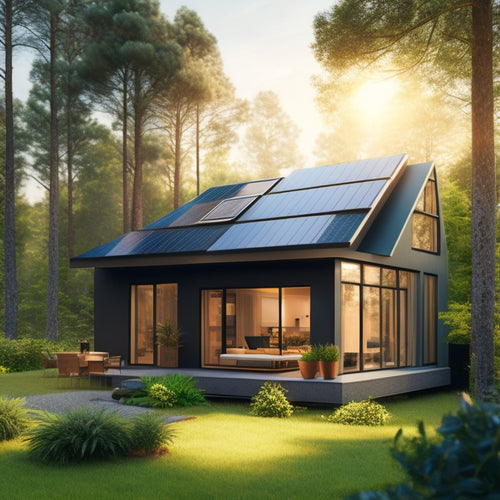
How Much Does It Cost to Install Solar Panels on a House
Share
You can expect to pay between $15,000 and $30,000 to install solar panels on your house, with the total cost depending on the type and quality of panels, system size, and local installation costs. The cost per watt of solar panels ranges from $1.50 to $3.50, with higher-efficiency panels costing more. Factors like system size, location, and local regulations also affect the overall cost. Additionally, you may be eligible for financing options, local incentives, and rebates that can reduce your expenses. As you consider investing in solar energy, understanding these factors will help you make an informed decision about your unique situation.
Key Takeaways
- The average cost of installing solar panels on a house ranges from $15,000 to $30,000, depending on system size and quality.
- System size, determined by household energy needs and roof size, affects overall cost, with larger systems costing more.
- The type of solar panel, such as monocrystalline, polycrystalline, or thin-film, influences cost, with monocrystalline being the most expensive.
- Location and regulations, including local permits and labor costs, can add $500 to $2,000 to the total installation cost.
- Financing options, such as loans and power purchase agreements, are available to help spread the cost of solar panel installation over time.
Average Cost of Solar Panels
As you evaluate shifting to renewable energy, one of the primary concerns is the cost of installing solar panels. The average cost of solar panels varies depending on the type and quality of the panels.
Monocrystalline solar panels, regarded as the most efficient, are typically the most expensive, ranging from $2.50 to $3.50 per watt. Polycrystalline solar panels, a more budget-friendly option, fall between $2.00 to $3.00 per watt. Thin-film solar panels, the least expensive, cost around $1.50 to $2.50 per watt.
When calculating the total cost, you'll need to take into account the system size, installation costs, and any additional features, such as inverters and mounting hardware. On average, a residential solar panel system can cost between $15,000 to $30,000.
Fortunately, financing options are available to help make the changeover more accessible. Many solar panel manufacturers and installation companies offer financing plans, such as loans and power purchase agreements, to help spread the cost over time. With the right financing option, you can start utilizing the power of solar energy without breaking the bank.
Factors Affecting Solar Panel Cost
As you consider installing solar panels, you'll want to understand the factors that affect their cost.
Two key considerations are the system size, which directly impacts the number of panels and overall expense, and your location, which influences permitting requirements and labor costs.
Additionally, the specific permits and regulations in your area will also influence the final cost of your solar panel installation.
System Size Matters
Your solar panel system's size greatly impacts the overall cost of installation. The system capacity you require is determined by your energy needs, which are influenced by factors such as your household's energy consumption, the size of your roof, and the amount of shade your roof receives. A larger system with a higher capacity will cost more than a smaller one.
To determine the ideal system size for your home, you'll need to assess your energy usage and identify the number of kilowatt-hours (kWh) you need to generate each month. A typical residential solar panel system ranges from 3 to 10 kilowatts (kW), with the average system size being around 5-6 kW.
When evaluating your energy needs, consider the following: the number of people living in your household, the number and type of appliances you use, and your heating and cooling systems.
A solar panel professional can help you determine the best system size and capacity to meet your energy requirements, ensuring you get the most out of your solar panel investment.
Location and Permit
The location where you plan to install your solar panels greatly affects the overall cost of installation.
You'll need to take into account local zoning regulations, which can vary considerably depending on your area. Some jurisdictions may have restrictions on the size, type, or placement of solar panels, adding to the overall cost. For instance, if you live in a historic district, you may need to use specialized panels that blend in with the surrounding design, which can be more expensive.
Additionally, you'll need to obtain installation permits from your local government, which can range from $500 to $2,000 or more, depending on the complexity of the project and the jurisdiction.
These permits guarantee that your solar panel system meets local building codes and safety standards. Be prepared to provide detailed plans and specifications for your system, as well as undergo inspections to verify compliance.
Cost by System Size and Quality
You'll find that the cost to install solar panels varies greatly depending on the system size you choose, ranging from small 2-3 kilowatt systems to large 10-15 kilowatt systems.
The quality of the system also plays an essential role in determining the cost, with high-efficiency panels and premium inverters falling into higher tiers.
As you investigate your options, you'll need to balance the upfront cost with the long-term benefits of each system size and quality tier.
System Size Options
Different households have varying energy requirements, and solar panel systems come in diverse sizes to address these needs. When considering installing solar panels, you'll need to assess your energy needs to determine the right system size for your home. This involves evaluating your daily energy consumption, roof size, and local building codes.
| System Size | Average Cost | Average Energy Output |
|---|---|---|
| 2-3 kW | $5,000-$7,000 | 2,500-3,500 kWh/month |
| 5-7 kW | $12,000-$18,000 | 6,250-9,100 kWh/month |
| 10-12 kW | $25,000-$35,000 | 12,500-15,600 kWh/month |
| 15-18 kW | $35,000-$50,000 | 18,750-22,800 kWh/month |
| 20-25 kW | $50,000-$70,000 | 25,000-31,250 kWh/month |
System size considerations are essential in ensuring you generate enough energy to power your home while staying within your budget. An energy needs assessment will help you determine the ideal system size for your specific situation.
Quality Tier Pricing
Beyond system size, the quality of your solar panel system also greatly impacts its overall cost.
You'll find that premium panels from top manufacturers like SunPower or Panasonic come with a higher price tag due to their high-efficiency rates and extended warranties. These systems typically range from $2.50 to $3.50 per watt, resulting in a total cost of $15,000 to $21,000 for a 6 kW system.
On the other hand, budget options from manufacturers like Trina or Hanwha offer more affordable prices, typically ranging from $1.50 to $2.50 per watt. This would put the total cost of a 6 kW system at $9,000 to $15,000.
Keep in mind that while budget options may seem appealing, they often come with shorter warranties and lower efficiency rates. Be sure to weigh the pros and cons of each option carefully to determine which quality tier best fits your budget and energy needs.
Panel Efficiency Costs
As you investigate the world of solar panels, it's vital to understand how panel efficiency affects your wallet. Panel efficiency refers to how well a solar panel converts sunlight into usable electricity. A higher efficiency rating means more energy output per hour of sunlight.
When considering panel efficiency costs, you'll notice that higher-efficiency panels come with a higher price tag. For instance, a 5-kilowatt (kW) system with high-efficiency panels (20% or higher) can cost between $15,000 and $20,000. In contrast, a 5-kW system with standard-efficiency panels (15% to 18%) can cost between $10,000 and $15,000.
While high-efficiency panels may seem like a luxury, they can be beneficial for homeowners with limited roof space. They can also provide better panel performance and energy output, even in low-light conditions.
However, for those with ample roof space, standard-efficiency panels may be a more cost-effective option. Ultimately, it's important to weigh the pros and cons of panel efficiency costs against your energy needs and budget.
Installation Costs and Labor Fees
With solar panel installation, you'll need to factor in the costs of hiring a professional team to do the job. The installation process involves a range of tasks, from evaluating your roof's condition to connecting the panels to your electrical system.
These tasks require specialized skills and equipment, which is why it's crucial to hire a qualified installer.
The labor fees for solar panel installation vary depending on several factors, including the installation techniques used, labor rates, and the complexity of the job.
Here are some key factors that influence labor costs:
- Installation techniques: The type of installation method used, such as roof-mounted or ground-mounted, affects labor costs.
- Labor rates: The cost of hiring a professional installer varies depending on their experience, location, and reputation.
- System size: Larger systems require more labor hours, increasing the overall cost.
- Permitting and inspections: Obtaining necessary permits and passing inspections can add to labor fees.
On average, labor costs account for around 10% to 20% of the total installation cost.
Roof Size and Complexity Matters
How does your roof's size and complexity impact the installation process? It's a significant factor in determining the cost of installing solar panels on your house. A larger roof typically requires more solar panels, which increases the overall cost.
However, a more complex roof with multiple angles, skylights, or vents may require specialized installation equipment and techniques, adding to the expense.
Your roof's orientation also plays an essential role. A south-facing roof receives the most sunlight, making it ideal for solar panels. East- or west-facing roofs can still generate significant energy, but may require more panels to compensate for reduced sunlight.
Shading issues, such as trees or nearby buildings, can further reduce energy production and increase installation costs.
To accurately assess your roof's size and complexity, a professional solar installer will conduct a site assessment. They'll evaluate your roof's dimensions, orientation, and potential shading issues to determine the best solar panel configuration and installation approach.
This customized approach guarantees you get the most out of your solar panel system while minimizing costs.
Local Incentives and Rebates Available
Beyond the roof's impact on installation costs, local incentives and rebates can substantially reduce the overall expense of going solar.
You may be eligible for various incentives, depending on your location and the type of solar panel system you install.
Here are some potential incentives you should investigate:
-
Federal tax incentives: You can claim a tax credit of up to 26% of the total cost of your solar panel system.
-
State rebates: Many states offer rebates or upfront discounts on solar panel installations. These rebates can range from a few hundred to several thousand dollars.
-
Local government incentives: Your local government may offer additional incentives, such as property tax exemptions or low-interest loans.
- Utility company incentives: Some utility companies offer rebates or special rates for customers who install solar panel systems.
Battery Storage System Costs
When you're sizing up the cost of going solar, don't overlook the additional expense of a battery storage system. This vital component enables energy independence by storing excess energy generated during the day for use at night or during power outages.
The cost of a battery storage system varies depending on the installation options you choose. A typical system can range from $5,000 to $15,000 or more, with the battery lifespan lasting around 10 to 15 years.
In comparison, the cost of solar panels alone can be around $15,000 to $30,000. Technology advancements have improved system integration, making it easier to combine solar panels with battery storage.
Financing options are also available, allowing you to spread the cost over time. While maintenance requirements are minimal, it's important to take them into account in your overall cost calculation.
Maintenance and Repair Expenses
You'll need to take into account maintenance and repair expenses to get an accurate depiction of the total cost of owning a solar panel system. While solar panels are relatively low-maintenance, you'll still need to perform routine inspections and cleaning services to guarantee peak performance.
Unexpected repairs can occur, and you'll want to budget for these expenses.
Here are some maintenance and repair expenses to keep in mind:
-
Routine inspections: Regularly inspecting your system can help identify potential issues before they become major problems. These inspections can cost around $100 to $300 per year.
-
Warranty coverage: Most solar panels come with a warranty that covers repairs and replacements for a certain number of years. Be sure to review your warranty coverage to understand what's included.
-
Inverter replacement: Inverters typically need to be replaced every 10 to 15 years, and this can cost around $2,000 to $5,000.
- System upgrades: As technology advances, you may want to upgrade your system to improve its performance. These upgrades can cost around $1,000 to $3,000.
Long-Term Savings and Payback
After considering the maintenance and repair expenses, it's time to look at the benefits side of the equation.
You'll be pleased to know that the long-term savings and payback of solar panels can be substantial. Over their 25-year lifespan, solar panels can save you thousands of dollars on electricity bills. In fact, according to the US Department of Energy, the average American family can save up to $500 per year on their electricity bills by switching to solar power. This translates to a total savings of $12,500 over the 25-year lifespan of the solar panels.
Beyond the financial benefits, solar panels also offer a sense of energy independence and a reduced environmental impact.
By utilizing renewable energy from the sun, you'll reduce your reliance on fossil fuels and lower your carbon footprint. This not only benefits the environment but also contributes to a cleaner, healthier community for you and your neighbors.
With solar panels, you'll be doing your part to reduce greenhouse gas emissions and promote a sustainable future.
Frequently Asked Questions
Do Solar Panels Work During Power Outages?
You're wondering if solar panels work during power outages. Typically, they don't, since the system is grid-tied for safety reasons. However, with battery storage options, you can guarantee continuous power supply, depending on your solar panel efficiency and storage capacity.
Can I Install Solar Panels on a Metal Roof?
As you envision utilizing the sun's energy, you wonder if your metal roof is a suitable canvas; have confidence, you can install solar panels on it, but consider the unique installation considerations, such as specialized clamps and waterproofing, to guarantee a seamless integration.
Will Solar Panels Increase My Property Taxes?
You're wondering if solar panels will increase your property taxes; the answer is, it depends on your location. Many states offer property tax exemptions or special solar panel assessments, which can minimize or eliminate any potential tax hike.
Do Solar Panels Require Frequent Cleaning?
Just like a well-oiled machine, your solar panels need regular tune-ups to run efficiently. You'll find that solar panel maintenance involves occasional cleaning, but don't worry, it's not a daily chore - cleaning frequency depends on your location and climate, but generally, it's every 6-12 months.
Can I Sell Excess Energy Back to the Grid?
You can sell excess energy back to the grid through a process called net metering, earning energy credits that offset your consumption when the sun isn't shining, and a grid connection enables this seamless exchange.
Conclusion
As you weigh the costs and benefits of going solar, remember that investing in solar panels is a long-term play. While the upfront costs may seem steep, they'll eventually pay off when the sun shines bright. With the right system and installation, you'll be "cooking with gas" in no time, reaping the rewards of renewable energy and reducing your carbon footprint.
Related Posts
-

Master Advanced Solar Panel Design Online for Free
You can master advanced solar panel design online for free by leveraging specialized courses and training platforms, ...
-

Why Cities Need Smart Charging Infrastructure Now
You're about to experience a tidal wave of electric vehicles hitting your city's streets, and it's essential you're p...
-

Reduce Solar Panel Cost for Your Small Home
By evaluating your energy needs, choosing the right installer, and selecting cost-effective solar panel options, you ...


